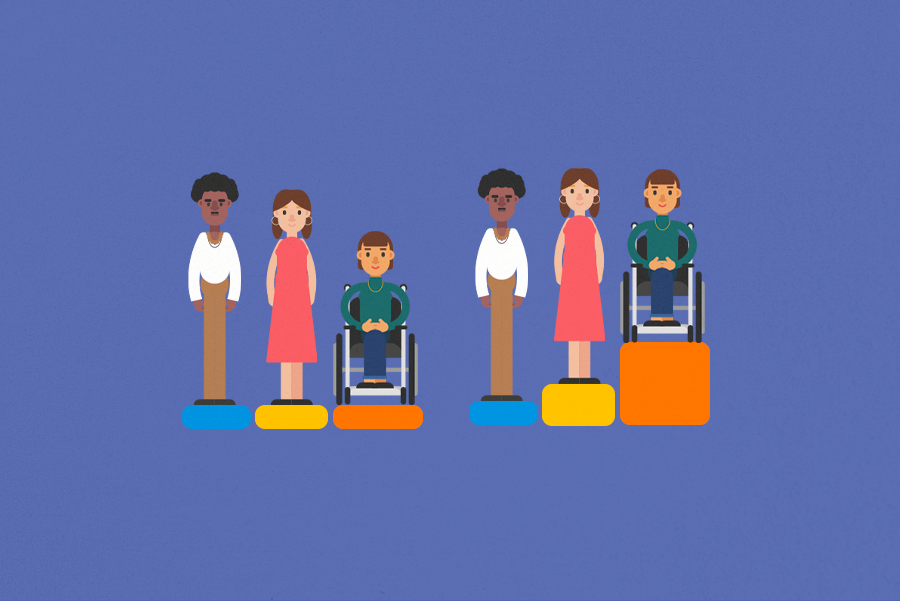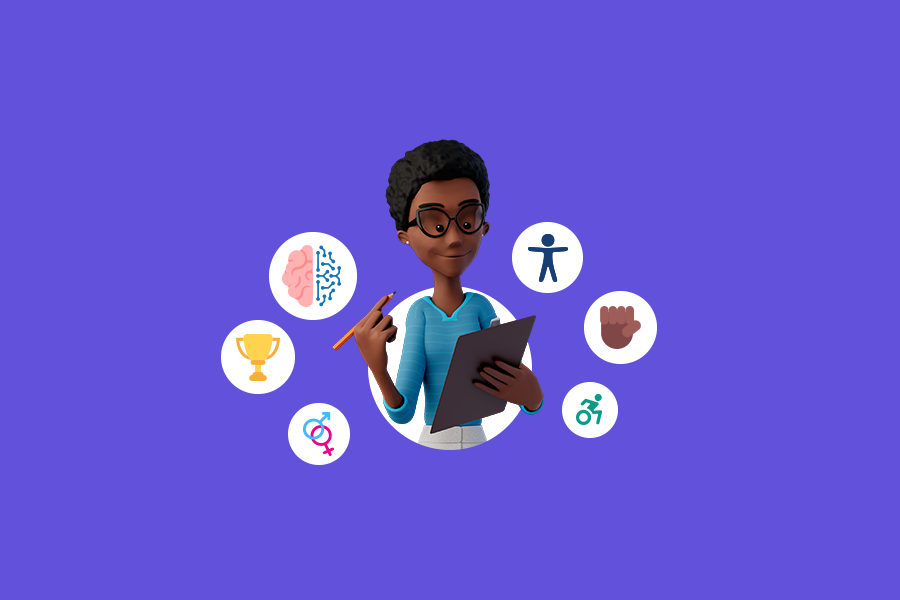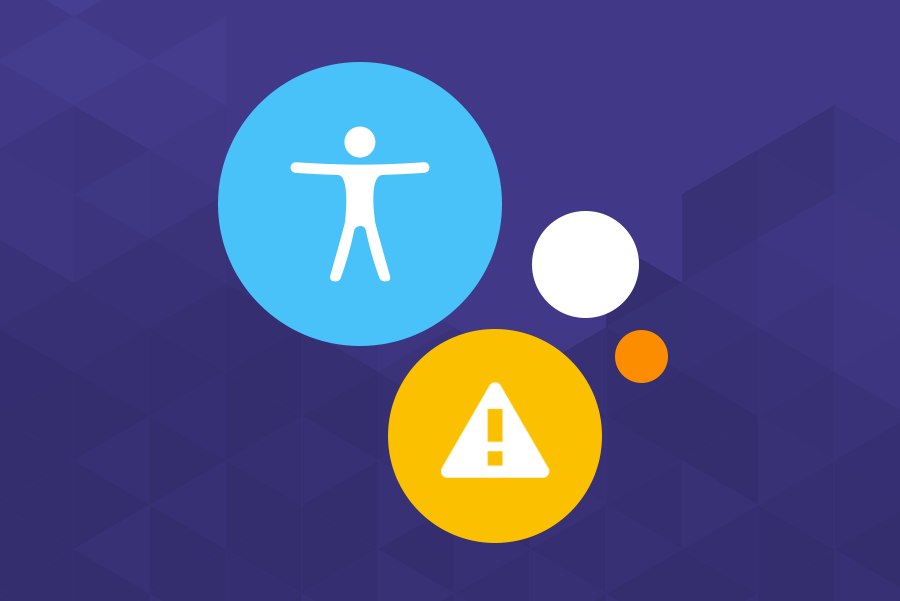
Equality and equity: what is it and how does it actually work?

Unfortunately, there is a lot of segregation and social inequality nowadays. In reality, there always has been, with this characteristic sometimes being more intense at certain times and milder at others, but always present.
To address this problem, political and socioeconomic strategies are devised with the aim of promoting equality or equity in society. These two concepts are closely related and often confused, but they have different definitions and intentions.
Let’s delve a bit deeper into these concepts. Join us!
What is equality?
In recent years, equality and its variations have become a widely discussed topic, whether in public policies or in social, economic or ideological issues. But what does it mean?
In theory, equality translates to treating people in the same way, without discrimination, ensuring access to the same opportunities for all. Therefore, equality is based on the idea that no one should be disadvantaged due to any condition, origin, belief, conviction or any similar reason.
To address the topic of equality, it is necessary to consider inequality, which is its antonym and an essential factor for the existence of equality in practice.
Example of equality
Equality is applied to various causes, especially gender equality, the rights of people with disabilities, and different ethnic groups. To promote it, it is valid to support organizations that share this ideal and promote public policies aimed at it.
Furthermore, it is important to assist individuals in vulnerable situations and advocate for actions against inequality in everyday life.
These are some simple ways to embrace equality in daily life. Now that we have clarified this concept, it will be easier to understand the concept of equity.
What is equity?
While equality promotes equal opportunities for all individuals regardless of their needs, equity aims to balance the inequalities among them, considering their unique characteristics and promoting equal access to resources to achieve the same outcome.
In other words, equity seeks to address people’s needs so that they have genuine access to the same opportunities, taking into account all the circumstances that set them apart.
Example of equity
In practice, equity is applied in various areas, as it offers a fairer treatment than equality. For example, in hospitals and emergencies, patients are prioritized based on their health condition. Therefore, treatment is based on the severity of the condition rather than the order of arrival. Those in need of urgent treatment are given priority over those with less severe health issues, ensuring equal opportunity for both but tailored to their individual needs.
Another example is when a person with a disability is included in a workgroup with all the necessary accommodations to perform tasks just like other team members.
These are just a few ways equity manifests in society, but there are many ways to promote it every day. However, if both equality and equity aim to ensure identical opportunities for all individuals, how do they differ?
What is the difference between equity and equality?
The main factor that makes them similar is their goal of ensuring justice, but they use different strategies to achieve it. Equality promotes equal treatment regardless of each individual’s personal needs.
On the other hand, equity seeks to equalize people by focusing on their specific needs, ensuring they have equal opportunities in a fair manner.
The best way to understand the difference between them in practice is through the following example: if three people of different heights receive the same-sized ladder, each one, when climbing the ladder, will end up at a different height, maintaining the height difference between them. This represents equality.
In the case of equity, ladders of different sizes, proportional to each person’s height, would be distributed, allowing everyone to reach the same height.
It is clear that the main distinction between these concepts is that equality only looks at the outcome, while equity embraces diversity among individuals and focuses on the resources needed for them to achieve the same outcome fairly.
Where do equality and equity apply?
As mentioned earlier, equality and equity can be applied in all areas of society that involve interpersonal relationships and are constantly influenced by the context in which they exist.
Here are some areas where they can be applied:
Equality and equity in education
Equity in education is based on understanding the different life contexts that affect a student’s school life, including factors such as purchasing power, gender, sexual orientation, ethnicity, and even abilities.
Recognizing these factors allows for improvements in the education system and, consequently, equalizing opportunities for all individuals.
Some rules imposed by many educational institutions work against this goal, such as punishments for tardiness and dress codes, which contribute to the segregation of students who do not have the same resources.
Socioeconomic factors play a significant role in education and students’ performance, with social vulnerability situations compromising the learning of these individuals.
To level the playing field for students to compete for the same opportunities fairly, measures such as quotas have been implemented, where individuals with similar life contexts compete separately from those who were more privileged during their basic education.
Despite the contradictions, resources like these are responsible for ensuring equality in education through equity.
Equality and equity in society
There are various tactics that can be applied to transform society into a more equitable environment, from everyday actions practiced by citizens to public policies aimed at this goal.
Urbanization, for example, directly affects the opportunities an individual will have access to. It is one of the main factors influencing socioeconomic context, job availability, services, and income.
Equality and equity in the workplace
Another area where equity and equality are essential is in the workplace. Currently, it is common to have job application processes specifically for people with disabilities to encourage inclusion. However, beyond inclusive processes, it is important to consider the entire journey of these employees.
Companies should have a policy against prejudice and exclusion in the workplace and beyond, which can encompass religion, gender, sexuality, ethnicity, and disability.
The best way to promote equality in the workplace is through impartiality in recruitment processes, as well as salary equality, which should not be influenced by any inherent factor related to the role and tasks performed.
However, equity can also be applied in this context by analyzing the company’s internal metrics to identify if there is any pattern in recruitment or promotions that excludes any group.
Impartiality is crucial for evaluating professionals or during any selection process. Opinions should not interfere in any decision, and merit should be the only criterion.
How to promote equity in the corporate environment?
The corporate environment must be neutral and not promote any form of prejudice or inequality among professionals. But how can this be put into practice?
Raise awareness within teams
Raising awareness about inequality and empathy are key factors in promoting equity in any environment.
You can address this topic through training sessions, lectures, courses, and incentives to help professionals understand how to implement equity in their daily interactions with colleagues. Such actions are responsible for spreading knowledge on the subject, which encourages the team.
Foster an inclusive leadership
Managers should lead by example and personally promote equality among all employees, including themselves.
Leaders are responsible for encouraging inclusive training and fostering this attitude in the company’s day-to-day operations.
Equalize salaries and promote female leadership
Gender pay inequality is still prevalent, with women historically receiving lower salaries for performing the same job as men. This still occurs today, although less frequently, due to gender bias.
One of the primary ways to combat this inequality is to evaluate professionals based on their abilities during recruitment, rather than their gender. It is also crucial to promote salary equality and encourage women’s leadership.
Implement individual development programs for marginalized groups
Before we continue with this section, let’s correct a term that is still commonly used: “minority groups.” In reality, these groups are not minorities; they are part of a majority that is marginalized by various layers of prejudice. Therefore, it is essential to use the correct term when referring to these groups, treating them as “marginalized groups.” These individuals also face challenges in the job market, similar to women, and democratizing access to the same opportunities is essential to achieve equality.
To achieve this, various organizations offer individual development programs to encourage inclusion and level the playing field for professionals, even those who are already established.
Create diversity committees and/or affinity groups
To meet the needs of diverse employees, it is beneficial to establish a diversity committee that leads inclusive initiatives in the workplace.
These committees can provide support to employees and create a space for discussions and clarification of doubts on the subject.
Conclusion
Although very similar, equality and equity have distinct objectives, but both are essential in our society. Respecting diversity and celebrating differences is what makes the world a fairer and better place.
If you want to learn more about the subject and even initiate actions to transform your workplace, keep following the Hand Talk Blog!


